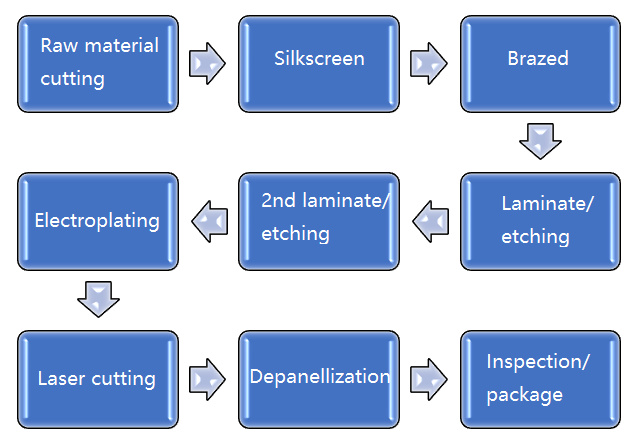AMB PCB is a kind of ceramic PCB, its full name is Active Metal Brazing Ceramic PCB. AMB technology is an advancement of Direct Bonded Copper (DBC) technology. Its working principle involves bonding ceramics to metals by utilizing active metal elements (such as Ti/Ag/Zr/Cu) in the brazing material. In terms of performance, the bonding in AMB ceramic substrates is achieved through a chemical reaction between the ceramics and active metal brazing material at elevated temperatures. Compared to traditional Al2O3 ceramic substrates, the Si3N4 ceramic used in AMB has a higher thermal conductivity (>90W/m.K at 25°C) and a thermal expansion coefficient closer to silicon (2.6x10 -6 /K). As a result, AMB substrates possess higher bonding strength and reliability.
Combined with silver sintering technology and high-power silicon carbide chips, AMB copper layers with active metal coatings can achieve high-power, better heat dissipation, and high-reliability packaging modules (capable of withstanding 3,000 thermal shocks). AMB technology is widely used in electric vehicles, locomotives, and high-speed trains. The primary difference between DBC and AMB PCBs lies in the manufacturing process. Firstly, in DBC, the copper and ceramic are directly bonded, while in AMB, copper and ceramic are brazed using active metal solder, which requires an additional screen printing process. Before brazing, the active metal solder must be evenly applied to the ceramic substrate. Additionally, DBC products form copper through a single etching process, whereas AMB products with extra metal solder layers require an additional etching process to remove the solder, typically using hydrofluoric acid.
Currently, AMB ceramic substrates in practical applications can be categorized into three types based on the ceramic material: alumina, aluminum nitride, and silicon nitride substrates. Below is a comparison of the physical properties of these three materials:
|
Item |
Unit |
Al2O3 |
AlN |
Si3N4 |
|
Density |
g/cm3 |
3.7 |
3.3 |
3.22 |
|
Thermal conductivity |
W/(m.k) |
>20 |
>170 |
>80 |
|
Coefficient of thermal expansion (CTE) |
ppm/C 20~300C |
6.9 |
4.7 |
2.5 |
|
Bending strength |
Mpa |
>350 |
>350 |
>700 |
|
Dielectric constant |
@1MHz |
9.8 |
9.0 |
8.0 |
|
Dielectric loss |
@1MHz |
<0.0002 |
<0.0005 |
<0.001 |
|
Breakdown strength |
kV/mm |
>15 |
>20 |
>20 |
|
Volume resistance |
Ω.cm |
>10^14 |
>10^14 |
>10^14 |
|
Elastic modulus (Gpa) |
GPa |
330 |
320 |
320 |
Alumina Ceramic PCB
AMB alumina substrates are the most mature in terms of manufacturing processes among the three materials due to the widespread availability and low cost of alumina. This makes alumina the most cost-effective ceramic substrate for AMB. However, alumina ceramics have lower thermal conductivity compared to the other two materials, limiting their heat dissipation capabilities. Therefore, AMB alumina substrates are mostly used in fields with low power density and less stringent reliability requirements.
Aluminum Nitride Ceramic PCB
AMB aluminum nitride substrates offer higher thermal dissipation capacity, making them more suitable for high-power and high-current electronic devices. However, due to their relatively lower mechanical strength, the high and low temperature cycle impact life of aluminum nitride AMB substrates is limited, which restricts their application range.
Silicon Nitride Ceramic PCB
Silicon nitride ceramics have two crystalline phases: α-Si3N4 and β-Si3N4. The α phase is unstable and can easily transform into the stable β phase at high temperatures. High thermal conductivity silicon nitride ceramics typically contain more than 40% β phase. Thanks to the excellent properties of silicon nitride ceramics, AMB silicon nitride substrates exhibit outstanding high-temperature resistance, corrosion resistance, and oxidation resistance. Most importantly, because silicon nitride has a high thermal conductivity (>90W/mK) and thick copper layers (up to 800µm), it also has high thermal capacity and heat transfer properties. Therefore, AMB silicon nitride substrates are the most suitable base material for applications requiring high reliability, heat dissipation, and partial discharge resistance, such as automotive, wind turbines, traction systems, and high-voltage DC transmission equipment.

l High-power semiconductor modules
l High-frequency switches
l Wind power and solar energy
l Automotive electronics, locomotives
l Aerospace
l IGBT modules
l 5G communication electronics
l Medical devices
l High-power LED lights
l Industrial control and defense security systems
ISimply drop your email or phone number in the contact form, and we'll promptly provide you with a quotation.